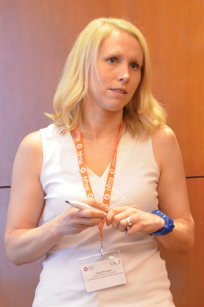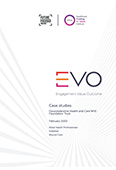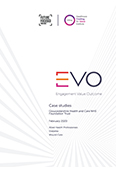Patient-level costing: value revolution
 All acute trusts are now calculating the costs of their activities at the patient level. And there are also a number of mental health and community providers that have switched to this more granular level of costing. However, this just gets providers to the starting line – the point of having patient-level cost (PLICS) data is to use it to inform decisions about clinical practices and to drive improvement.
All acute trusts are now calculating the costs of their activities at the patient level. And there are also a number of mental health and community providers that have switched to this more granular level of costing. However, this just gets providers to the starting line – the point of having patient-level cost (PLICS) data is to use it to inform decisions about clinical practices and to drive improvement.
This is where the Engagement Value Outcome framework – or EVO for short – comes in. Developed by the HFMA’s Healthcare Costing for Value Institute with Future-Focused Finance, EVO helps trusts to put PLICS data to work with the ultimate aim of its use being business as usual, just part of how services are managed.
It does this by providing a trained facilitator to run a number of workshops with multidisciplinary teams made up of clinicians, service managers, finance and informatics staff working in and supporting specific specialties and services.
Four trusts – two acute, one mental health and a community services provider – last year piloted the approach, each running the process in three separate service areas.
The results and feedback from those pilots are being published in four separate case study briefings. Two are available now (Gloucestershire Health and Care NHS Foundation Trust and North Staffordshire Combined Healthcare NHS Trust), while two further studies (University Hospitals Birmingham NHS Foundation Trust and Great Western NHS Foundation Trust) are due to be published shortly.
The four trusts had different starting positions and different contexts, but there were some common themes in their assessment of the programme. All reported that the EVO work helped strengthen working relationships between clinicians and finance staff – a major result in itself, providing a robust platform for further work.
And there were numerous comments about clinicians starting to understand what all the fuss is about – how patient-level information and costing data can really provide them with a useful window on their work and help them to understand variation and address it where necessary.
 ‘The biggest thing about EVO for us was the discipline it affords in terms of getting everybody committed to being around that table for two hours in three separate slots,’ says Jenny Richards, senior planning and costing manager at Gloucestershire Health and Care NHS Foundation Trust, one of the pilot sites.
‘The biggest thing about EVO for us was the discipline it affords in terms of getting everybody committed to being around that table for two hours in three separate slots,’ says Jenny Richards, senior planning and costing manager at Gloucestershire Health and Care NHS Foundation Trust, one of the pilot sites.
‘That is so much productive time and the amount of benefit you can glean from that skillset around the table has moved us forward hugely. That’s not just in our understanding of the data but also our relationships across the clinical and non-clinical borders.’
Commitment pays off
She is clear about the commitment needed. There is a lot of work involved in supporting the process – especially for the costing and informatics teams in getting the data together for each session. Trusts embarking on the EVO framework themselves need to ensure they have resource put aside to cover this.
But she says the effort has been worth it. The trust is currently rolling out some of the improvements identified during the sessions and is now embarking on its first mental health service area, running the process solo without external EVO support.
That is the aim of the programme – to help trusts kick-start the process of using PLICS data to understand current practice and identify opportunities for improvement.
Gloucestershire Health and Care is no stranger to patient-level costing or to clinical engagement. The winners of the 2019 HFMA Costing Award, the trust has a track record of developing costing and working closely with clinicians to refine the quality and accuracy of its data. Even so, Mrs Richards says EVO moves them to the next stage.
‘We all believe in the data, but to get to the real nugget of clinical variation, do we have enough insight in the data? And if we don’t, can we get it?’
The trust explored three areas – allied health professionals, diabetes and wound care. Work on allied health professionals built on an earlier project in the Cheltenham locality (one of five areas covered by the trust). This had attempted to improve recognised data issues in therapy and district nursing services.
It led to more detailed recording of activities. For example, therapists had typically logged contacts with patients simply as physiotherapy or occupational therapy. But a new template was introduced that enabled therapists to provide details around the specific interventions delivered.
‘EVO gave us protected time to properly analyse what that data was showing us,’ says Mrs Richards. ‘And because we had the right people in the room, we got way more out of it than we would have without EVO.’
The EVO group also further refined the data that was being collected, getting rid of a catch-all ‘long-term conditions’ category and forcing practitioners to provide a more precise description of the activity.
Other trusts undertaking the EVO programme should expect to find that sometimes they don’t have the data at the right level of detail to help them uncover value.
But there are still insights that can be gained with the available data. Identifying the data you need – and having everyone bought into fixing it – is a successful outcome in its own right.
Arguably, the most progress the trust made was in diabetes, where the data clearly demonstrated that diabetes patients’ dependence on other services, such as district nursing, tissue services and podiatry, was as much as six times greater than non-diabetic patients. However, diabetic patients who had previously received a structured education programme that helped them to take control of their diabetes made far less use of these services.
Patients aged 45 to 64 not receiving the education programme cost 50% more on average than those with the education – 30% more for those aged 64 or over. The expansion of the education programme offers the potential to reduce demand for other services and, on the back of the EVO analysis, a business case is now being produced to do exactly that.
Staffordshire progress
North Staffordshire Combined Healthcare NHS Trust is one of the main providers of mental health, social care and learning disability services in the West Midlands.
It is one of only two specialist mental health trusts in the country to be rated ‘outstanding’ by the Care Quality Commission. And in March, a report from the CQC applauded the trust for the way it had sustained its improvement trajectory.
The trust started implementing PLICS in 2015 and now has a well-established system in place (winning the HFMA Costing Award in 2016). It has developed a standard PLICS dashboard and the costing team has its own Activity Information Dashboard (AID). This enables the team to present data in a user-friendly way, tailored to the needs of services.
While the trust had already started rolling out the use of PLICS, EVO was seen as a good way to encourage trust-wide interest in PLICS.
One of the areas chosen for the programme was crisis care, and the first workshop demonstrated how specific patient costs could be extracted and used alongside activity metrics to highlight variations.
The EVO group – made up of costing, finance and performance staff as well as the acute and urgent care directorate’s service manager and modern matron – decided to explore three areas. These included: the home treatment team; the access team; and e-rostering.
The home treatment team helps avoid admission to inpatient wards. But it also works with people in hospital as they prepare for discharge and then supports them as they make the transition back into the community.
In particular, the group wanted to test out the impact a home treatment intervention during a ward admission had on the length of inpatient stay. The PLICS analysis in fact showed that the overall average lengths of stay and costs for people was similar for people with and without a home treatment episode (not including the costs of the home treatment intervention).
The group discussed this apparent lack of impact. Some of the patients may not have been suitable for home treatment, it suggested, such as someone with relationship problems or someone admitted from a care home.
There could also be a cohort of patients in the data who had a number of readmissions and may not have received a home treatment intervention for each admission. However, regular readmissions could indicate that the pathway isn’t working as well as it could.
A review of an individual pathway for a patient with a pattern of admissions and discharges led to a conclusion that the patient may have been discharged too early, with a lack of input from the care co-ordinator. Looking at an individual’s pathway through AID was seen as a great way to visualise the care given and to start to understand if a pathway is working.
Overall, the group agreed to review communication between the home treatment team and wards and ensure patients completed or updated risk assessments before discharge. There was also a commitment to explore how effective home treatment was for people readmitted to a ward.
Before the EVO pilot, the trust was not collecting information on inpatient dependency and the group were keen to see if the new e-rostering system could be used to record staffing levels needed for each patient on a ward. Seven dependency measures were used, ranging from general observations up to a single patient needing three staff to care for them, and a census was carried out three times a day on the pilot ward.
Analysis showed that actual staff hours on the ward (for older adults with organic diagnosis and complex needs) were consistently lower than the numbers calculated using the dependency census data.
The data will inform discussions with commissioners, alongside other benchmarking data (showing the wards’ below average bed day costs), and the outcomes of safer staffing reviews. One clinical director said that ‘without information like this, complexity and acuity are just words in a sentence’.
Overall, the directorate clinicians involved in the EVO pilot were very positive about the skills of the costing team and the tools they use to present data. They particularly highlighted the visual presentation of the patient pathways, clearly demonstrating the complexity and, occasionally unco-ordinated nature of pathways for individual patients.
Birmingham merger
University Hospitals Birmingham NHS Foundation Trust was one of the acute pilots on the EVO programme, with a focus on dermatology, trauma and orthopaedics and vascular surgery. Its 2018 merger with Heart of England NHS Foundation means that the trust now has five major hospital sites – including the Queen Elizabeth Hospital; Heartlands; Good Hope; Solihull; and the Birmingham Chest Clinic.
 This merger has already prompted a major review of clinical services to streamline and consolidate activities and address unwarranted variation. Participation in EVO was a way of supporting this process.
This merger has already prompted a major review of clinical services to streamline and consolidate activities and address unwarranted variation. Participation in EVO was a way of supporting this process.
Clara Day, nephrology consultant and associate medical director of finance at the trust, told the HFMA annual conference in December that there were four lessons from the trust’s experience with EVO. ‘Don’t underestimate the importance of proper time – that’s external project, executive-sponsored, three-line whip time – people have to attend,’ she said. ‘Second, the data used in improvement is not the same as data used in research, but it is good enough.’
 She said this was a particular aspect with which clinicians needed to be comfortable, although she warned that data needed to be presented in ways that clinicians found easy to process. Pictures not pivot tables, she suggested. Clinicians involved in the project at UHB now characterised the patient-level approach as providing information rather than just data.
She said this was a particular aspect with which clinicians needed to be comfortable, although she warned that data needed to be presented in ways that clinicians found easy to process. Pictures not pivot tables, she suggested. Clinicians involved in the project at UHB now characterised the patient-level approach as providing information rather than just data.
‘Number three is the importance of conversation,’ Dr Day added. ‘How many times do we have a strict agenda in meetings, which means you don’t get conversation and dialogue?’
Finally, she said, the information and insight had to lead to action. ‘Data shows you where the variation is, but you’ve got to put it into business as usual and translate it into transformed healthcare.’
The EVO has had successes at all four of the pilot sites. Perhaps its biggest achievement is in strengthening relationships between clinicians and their finance and informatics colleagues.
Even where good relationships already existed, it has brought the communities closer together and the protected time in each other’s company has enabled real discussions to take place. The detailed data provides opportunities to back best guesses about causes and impacts of different activities with hard fact. Or in cases where the data is not detailed enough to do this, it provides a clear indicator of what data would be necessary to deliver that insight.
A second wave of the EVO programme is currently being planned, taking on board lessons learnt from the pilot programme. The start date for this is uncertain, given the extreme challenges facing the NHS as a result of the Covid-19 coronavirus pandemic. However, the results so far suggest that EVO offers a practical way to get trusts using patient-level cost data to inform service improvement and to put the theory of value-based healthcare into practice.
For a summary of the EVO pilot and cases studies on the pilot sites go to hfma.to/evo
Related content
We are excited to bring you a fun packed Eastern Branch Conference in 2025 over three days.
This event is for those that will benefit from an overview of costing in the NHS or those new to costing and will cover why we cost and the processes.